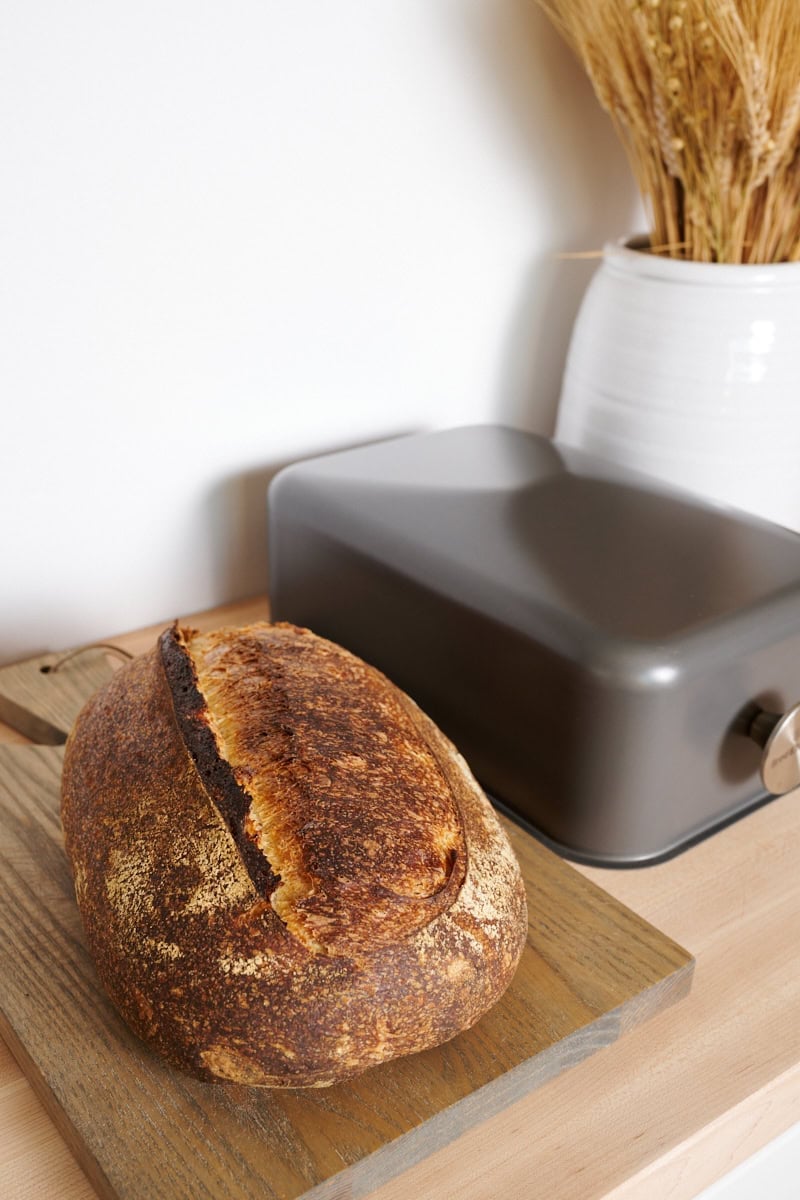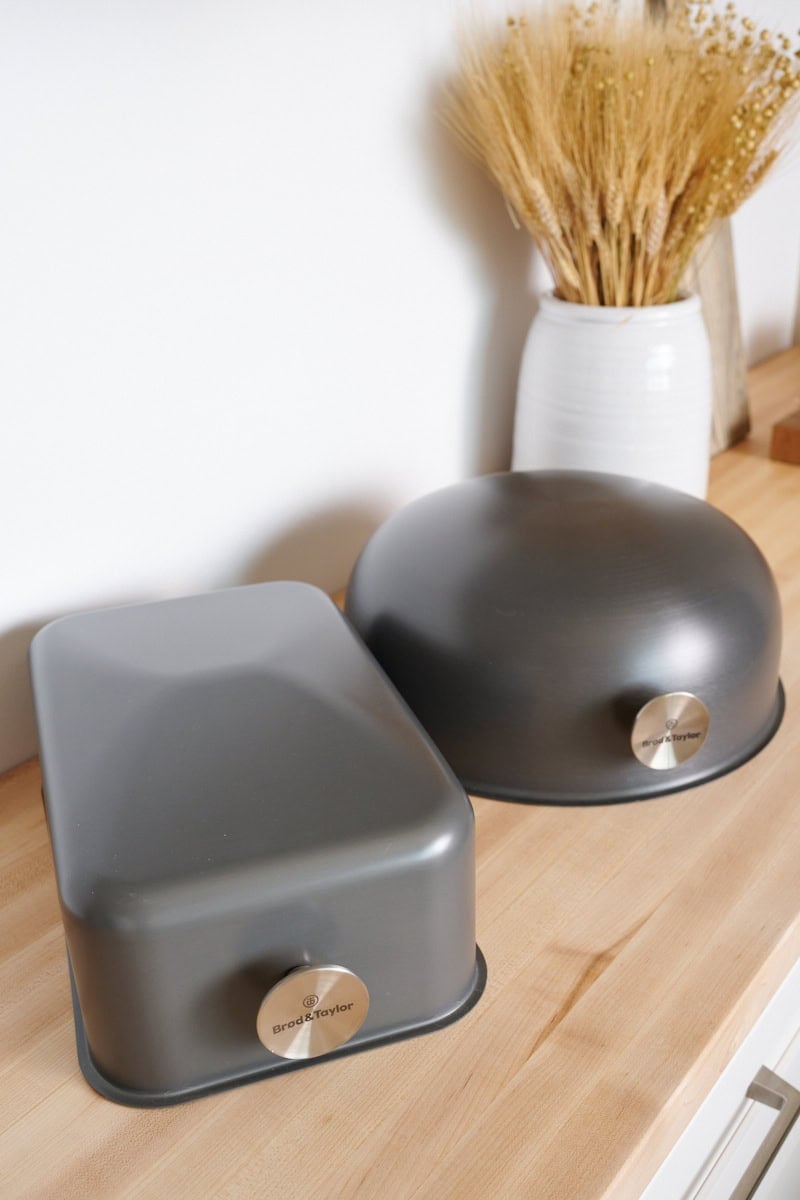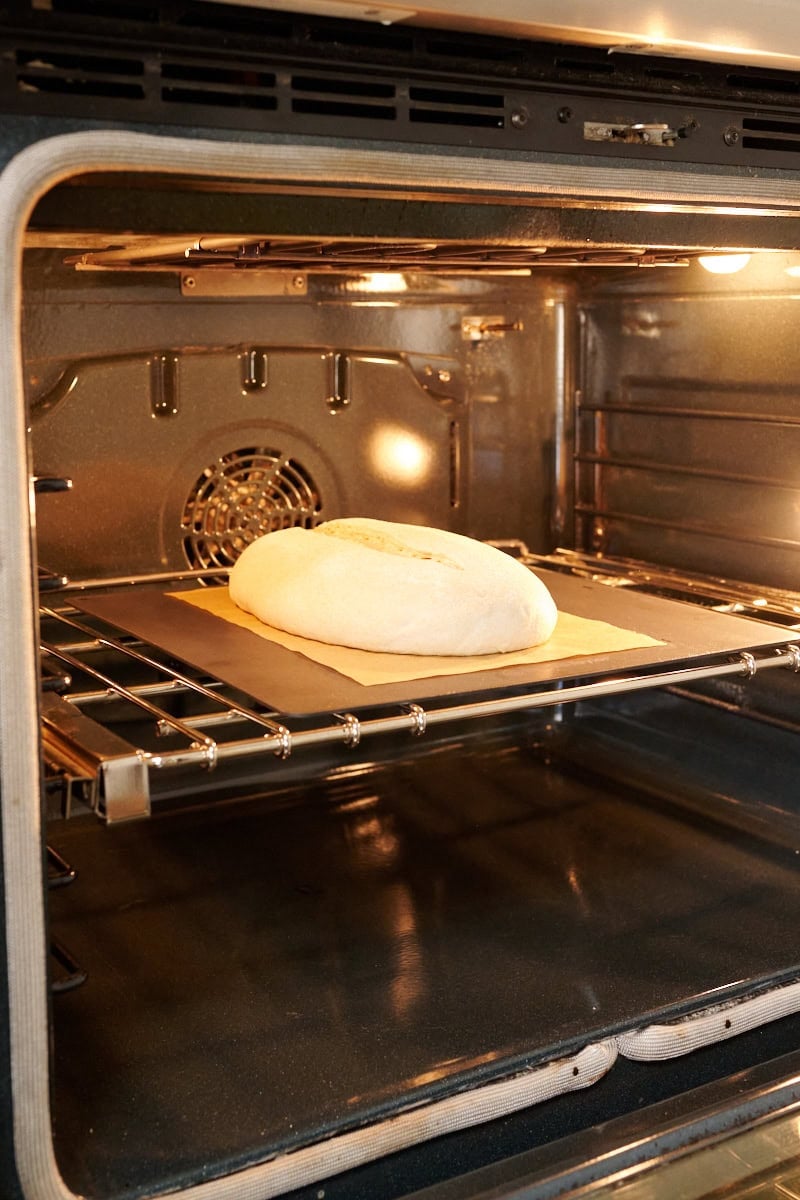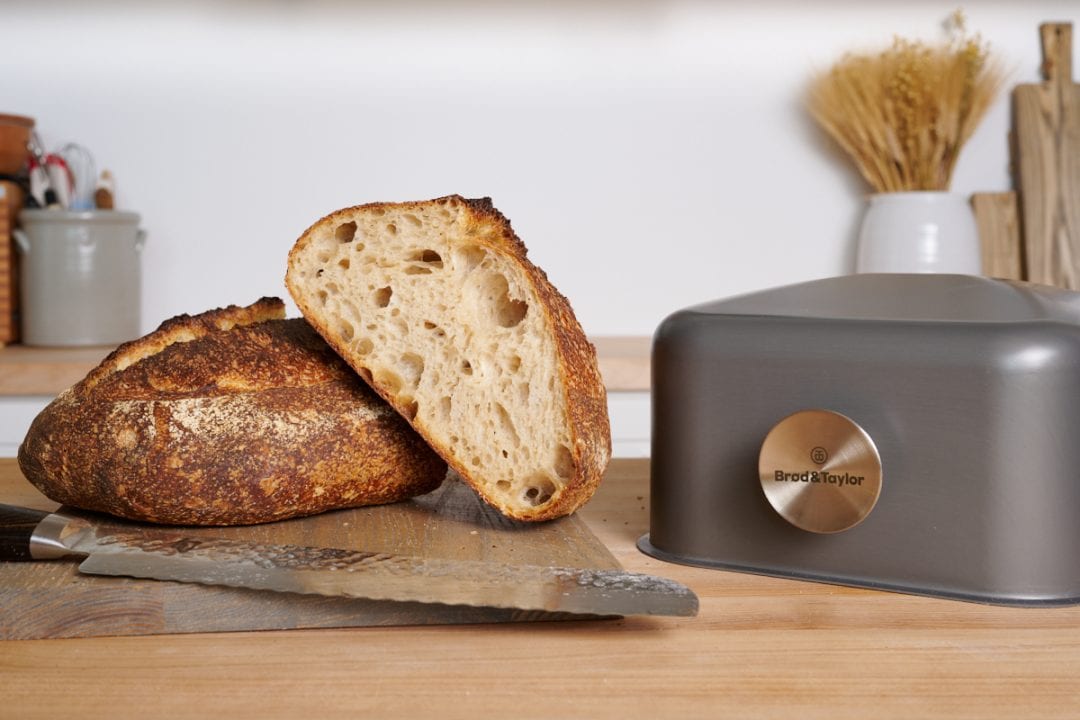Over the past 10+ years I’ve been baking sourdough bread, I’ve developed and tested many methods for steaming the home oven when baking sourdough bread. Steam at the start of baking is critical for optimal loaf volume and a crispy crust. But, I’ve found this can be one of the most challenging (and frustrating) steps in the entire process.
As home bakers, we don’t have access to professional ovens that steam the interior at the press of a button. So we’ve had to come up with workarounds.
The Dutch oven (or combo cooker) has been a one of these popular workarounds. This heavy cast iron pot bakes bread well by trapping steam and transferring heat effectively. Its main drawback? It’s very heavy.
Enter the Baking Shell. It’s a lightweight (it weighs about 1 pound!) metal cover you simply place over your bread dough during the initial part of baking to trap steam. No more heavy cast iron pot and lid to lug around.
ℹ️ Full disclosure: I collaborated with Brod and Taylor on designing the Baking Shell, from initial sketches to final prototype testing. I’ll be financially compensated for a limited time for my involvement. However, I truly believe this is one of the best methods for baking sourdough bread at home and it makes the process much easier!

I’ve been working with my friends at Brod and Taylor for many months, designing, testing, and iterating on this elegant solution. It has gone through many rounds of manufacturing in the search for the right material, color, shape, knob design, and much more. Ultimately, the final shell is perfect for making your favorite sourdough bread.
Okay! Let’s dive into the details.
Real Quick: Why Do I Love The Baking Shell?
- It effectively traps steam during baking for optimal loaf volume
- It’s incredibly light and easy to handle (it weighs about 1 pound!)
- It gives my bread an excellent crust with little effort
- It does not have to be preheated to be used
- It’s an elegant solution to an age-old bread-baking problem

What is The Baking Shell?
The Baking Shell by Brod and Taylor is a lightweight cover you can place over bread dough on a baking surface during the start of the baking phase. It acts like a Dutch oven or combo cooker, trapping the steam escaping from the dough as it bakes to encourage optimal loaf volume and a crispy, caramelized crust. It’s made from lightweight aluminum (which has excellent thermal properties) and compared to a heavy cast iron pot, the Baking Shell is far easier to handle.
In terms of weight and size, the Baking Shell is light and spacious, meaning you can move it with a single hand and fit large loaves underneath, even my Beginner Sourdough recipe at 900 grams per loaf.
Keep in mind that the Baking Shell does require a baking surface to bake on top of, it’s not a closed vessel. The benefit here is that you can buy a thin piece of steel, like the Bread Steel, or use your existing baking stone or steel (more on this later).
As seen below, the Baking Shell comes in two sizes: round for a boule, and oval (or rectangular, really) for a batard or demi-baguettes.

How the Baking Shell Works
Since the Baking Shell is made from thin and lightweight blackened aluminum, it heats rapidly and is excellent at conducting heat and emitting thermal radiation—that is, the primary heat in a home oven. This means the shell transfers the oven’s heat directly to the bread dough extremely quickly.
It almost acts like it’s not there at all—except that it is doing one important thing: trapping steam.
Here’s a look at why the Baking Shell works so well:
- The black color is an excellent absorber of thermal radiation, a.k.a. oven heat (especially compared to shiny steel)
- Aluminum’s high thermal conductivity ensures even heat distribution, promoting uniform baking
- The shell can help keep a more constant temperature around the bread dough, reducing thermal fluctuations in a home oven
- The shell retains steam inside during the beginning phase of baking, critical for optimal loaf volume
But Wait, How is the Baking Shell Different From a Bowl or Pan?
For years I’ve known bakers who’ve used a stainless steel roasting pan or inverted mixing bowl over a baking stone to trap steam and bake their loaves. The Baking Shell is similar in theory, but superior because it’s made from ultralight aluminum and heats much faster than a steel bowl or pan.
Further, bowls and pans are usually reflective steel, which reflects more thermal radiation (heat) than a black surface.
Finally, compared to a roasting pan or mixing bowl, the Baking Shell’s front handle makes it easy to move in the oven, and the rolled rim of the shell forms a tight seal with whatever it’s resting on.
Watch Me Use The Baking Shell
The Brod and Taylor team travelled out to my home in Albuquerque, New Mexico to film me using the Baking Shell in action, check it out below.
What Can You Bake in the Baking Shell?
The Baking Shell comes in two shapes, a boule (round) and a batard (oval) shape. I’ve baked many recipes in both shells in testing, and it’s perfect for many of the recipes you’ll find at The Perfect Loaf, from round boules to oval batards and even demi-baguettes. Essentially, anything requiring steam at the start of baking.
Let’s look at each shape.
Batard Baking Shell

The batard baking shell is perfect for oval-shaped loaves. I’ve fit up to 1kg of dough under the shell, though I often bake 800 to 900g underneath.
The batard Baking Shell is great for dough proofed in 9, 10, or 14-inch proofing baskets.
| Height | Width | Depth |
|---|---|---|
| 5.5 inches (14 cm) | 8 inches inches (20 cm) | 12.5 inches (32 cm) |
Boule Baking Shell

The boule baking shell is perfect for round-shaped loaves. I’ve fit up to 1kg of dough under the shell, though I’m confident I could push this to bake a larger miche inside (1.2-1.4kg). I’m still testing the maximum capacity of the round shell.
The boule Baking Shell is great for dough proofed in 8 or 10-inch proofing baskets.
| Height | Width | Depth |
|---|---|---|
| 5.5 inches (14 cm) | 12.5 inches inches (32 cm) | 12.5 inches (32 cm) |
Step by Step: How To Use The Baking Shell
Using the Baking Shell is similar to how you’d use a Dutch oven or combo cooker, though the shell itself does not require preheating. Use the shell to cover the dough when you need steam, and remove it when you want to bake in a dry environment.





Here’s my process for using the shell:
- Place a baking surface (baking stone or steel, see more below) on a rack in the middle position of your oven. Preheat to 450°F (230°C). (The Baking Shell does not have to be preheated, though you can if you’d like.)
- Place parchment paper on a pizza peel and turn your dough out of the proofing basket onto the parchment paper
- Score the dough and slide the parchment onto the baking surface
- Cover the dough with the Baking Shell
- Bake for 20 minutes*
- Remove the Baking Shell and finish baking the dough until the crust is well colored and crunchy, about 30 minutes longer.
*The initial covered baking (with steam) might vary based on your recipe. See the section below for adjustments.
How Can I Get Thin Crusted Bread With the Baking Shell?
Using the Baking Shell, you can adjust the thickness of your crust by shifting the baking durations. For a thinner crust, instead of baking with 20 minutes with the lid on, extend this time to 30 minutes. Then, instead of baking the remaining 25-30 minutes without the lid, shorten it to 15-20 minutes to compensate.
| Crust Style | Time with Steam (Shell On) | Time Dry Baking (Shell Off) |
|---|---|---|
| Thicker, crunchier | 20 minutes | 30 minutes |
| Thinner, softer | 30 minutes | 15 to 20 minutes |
Thanks to Kevin in our Baking Corner for his tips when baking with the Baking Shell!

Are there Any Drawbacks to the Baking Shell?
Honestly, the Baking Shell is such an elegant solution a long-standing home baker’s problem: steaming the home oven when bread dough is inside baking. The only drawback I can see is that this is a specialty piece of equipment, meaning it’s made only for baking bread. But given how much bread I do make, and how easy it makes the process, it’s a worthwhile investment.
But, is there anything else we can use it for? Why, yes!
What Else Can I Use The Baking Shell For?
I’ve been using the Baking Shell as a bread box on my kitchen counter. Once you’ve let your loaf cool and you’ve cut into it, use the shell to cover it on the counter to keep moisture inside and prevent the loaf from staling quickly. I slice the loaf in half, cut as many slices as desired, then turn the cut sides down onto my cutting board and cover them both with the Baking Shell.
Yet another way to store your sourdough bread to ensure it stays fresher for longer ✅
Additionally, I use the large round Baking Shell to cover my dough after I’ve preshaped it to help prevent a skin forming on the dough before shaping. This is especially important if you have an air conditioner running or draft in your house.
What Can I Use As the Baking Surface?
In addition to creating the Baking Shell, Brod & Taylor has also recently released a thin slab of steel that’s the perfect balance of thickness and weight for baking bread: the Bread Steel.

The Bread Steel is the perfect pair with the Baking Shells (and it works with both the boule and batard shells). You can place it in your oven on the oven rack and preheat it. The steel will be fully preheated alongside your oven.
An important note when using the Bread Steel: be sure you place it on a rack a few slots up from the bottom of the oven (ideally the middle, as you see above) to avoid over-baking the bottom of your bread dough. The steel conducts heat very efficiently, and if it’s too close to a heating element, it can get too hot!
Bread Steel Dimensions
| Thickness | Width | Depth |
|---|---|---|
| 0.1 inches (0.25 cm) | 14 inches inches (35.5 cm) | 14 inches (35.5 cm) |
Baking Shell FAQs
Is the Baking Shell Better than a Dutch Oven or Challenger Bread Pan?
I would say the results in terms of final bread volume and crust color and texture are identical. The big difference between the Baking Shell and a Dutch oven, combo cooker, or Challenger Bread pan is workflow. It’s much easier to move the light shell to cover your dough than lug around a searing hot and heavy pot.
What is the Baking Shell made out of?
It’s made out of thin aluminum, an excellent radiator of thermal radiation—which is precisely what most of the heat is in a home oven. Additionally, making it from aluminum means the Baking Shell is light and easy to handle.
What’s Next?
To start with the Baking Shell, make my My Best Sourdough, which fits perfectly in the batard or boule shap. The shell really makes the dough spring in the oven.
Have any questions about the Baking Shell? Feel free to leave a comment below or send me over an email!





